
As pollution, engineering, population growth and climate change pose challenges to freshwater quality and quantity in America, the safety and amount of water in parts of the U.S. is in question.
Environmental experts told ABC News about the future of water in America and problems the country is facing now.
Where is America’s water crisis?
“The American West is certainly in a water crisis,” Reed Maxwell, a professor and researcher at Princeton University, told ABC News. Maxwell has been studying the distribution of freshwater resources in the hydrologic cycle with a focus on the impacts of manmade stresses for 20 years.
“Even with the record high precipitation in the 2022-2023 winter season for parts of the West, the decadal pattern is for continual aridification in the West,” said Maxwell. This means the West keeps getting drier and hotter. “It’s being amplified by human-induced climate change,” he said.
The story is different for the eastern U.S.
“The East is getting more intense rainfall and that’s not an issue for water supply, but it is an issue for flooding, and that becomes an infrastructure problem,” said Maxwell.
According to Colorado State University research, nearly half of the 204 freshwater basins they studied in the United States may not be able to meet the monthly water demand by 2071.
Only 2.5% of Earth’s water is freshwater, the kind we need to live, and nearly all of that water is underground.
That finite amount of freshwater is being stretched over a growing number of humans each year.
Freshwater from surface sources of freshwater such as rivers and reservoirs, and underground sources like aquifers supply the vast majority of Americans, more than 85%, through municipal water suppliers for clean water to their homes and businesses.
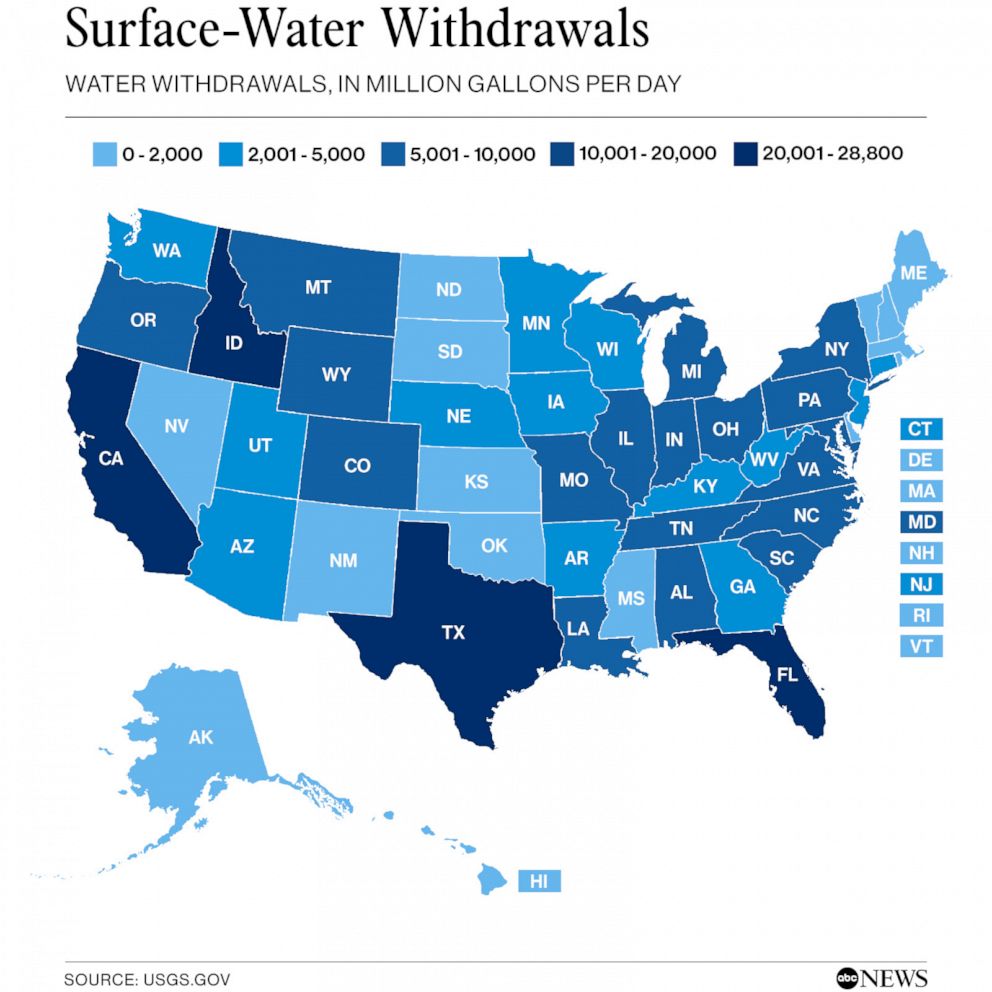
Surface-Water withdrawals in million gallons per day
ABC News / USGS.GOV
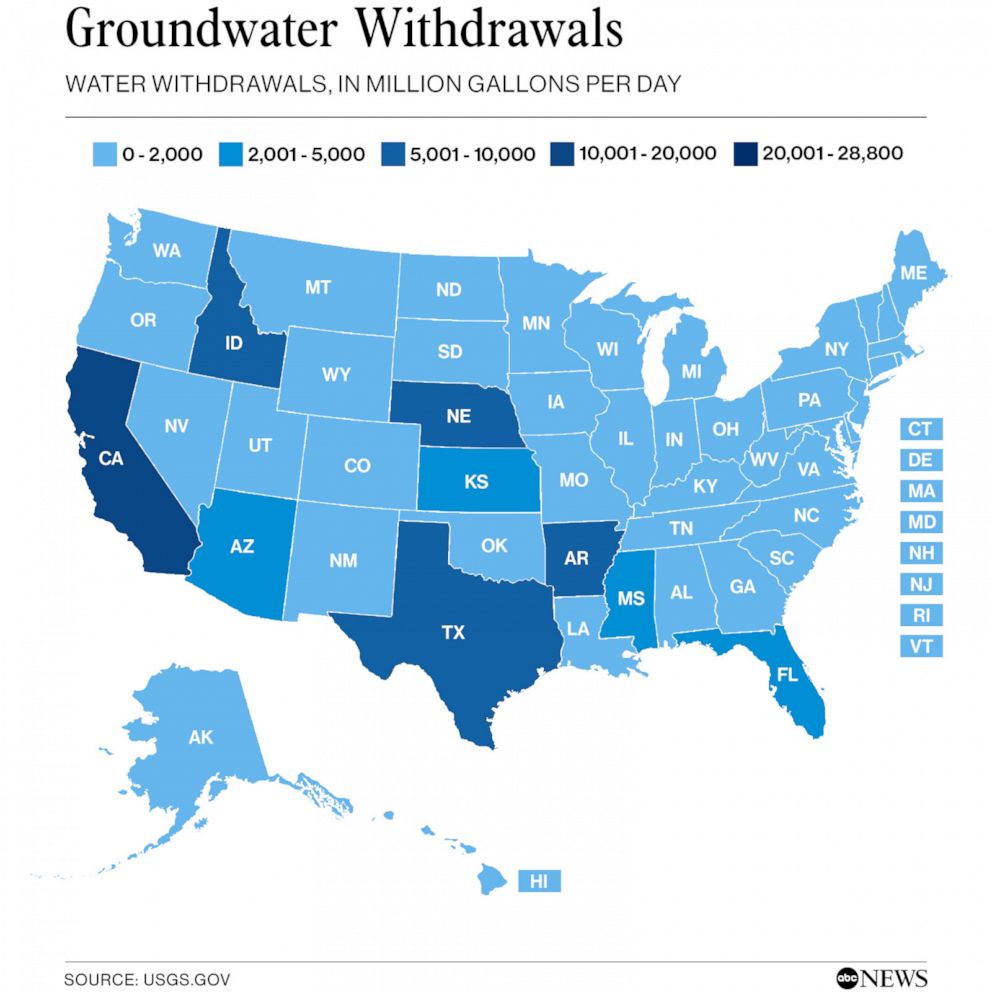
Water withdrawals in million gallons per day
ABC News / USGS.GOV
Is the growing population the problem?
In America, the sources for drinking water haven’t changed much over the last 70 years, but the population has grown by nearly 190 million.
With the advent of air conditioning, cities like Phoenix, Arizona and Las Vegas, Nevada saw a remarkable population boom.
However, the problem with population growth isn’t necessarily that more people are drinking more water, it’s that more people need food that is taking the majority of water.
Brad Udall, senior water and climate research scientist at Colorado State University, told ABC News, “Las Vegas now uses about 20% less water than they did in the year 2000, despite almost a million more people.”
“So, the problem is it comes down to what agriculture is going to do about this. Agriculture is somewhere around 75% of all water use in the lower Colorado River basin,” Udall said. “The cities are actually quite a tiny part.”
Humans need food and food needs water
According to the United Nations, more than 70% of Earth’s freshwater is used to irrigate the plants and animals we eat.
American Rivers, a national organization focused on clean water and river health, said the “water footprint” of the average American is 32,911 glasses per day. Ninety-six percent of that water footprint comes from growing the food we eat, generating energy and manufacturing clothes and other goods, the organization said.
The No. 1, and most important, solution to a water crisis is conservation, experts said. It is not just the reduction time spent in the shower, but thinking about how water intensive our food choices are.
“The other issue that’s come up that’s quite controversial is, you know, the Lower Colorado River Basin grows a lot of forage crops, right? Crops that go to dairy and beef cattle, other livestock. And the question is, is this a good use of water for forage crops that can be grown elsewhere?” Udall said.
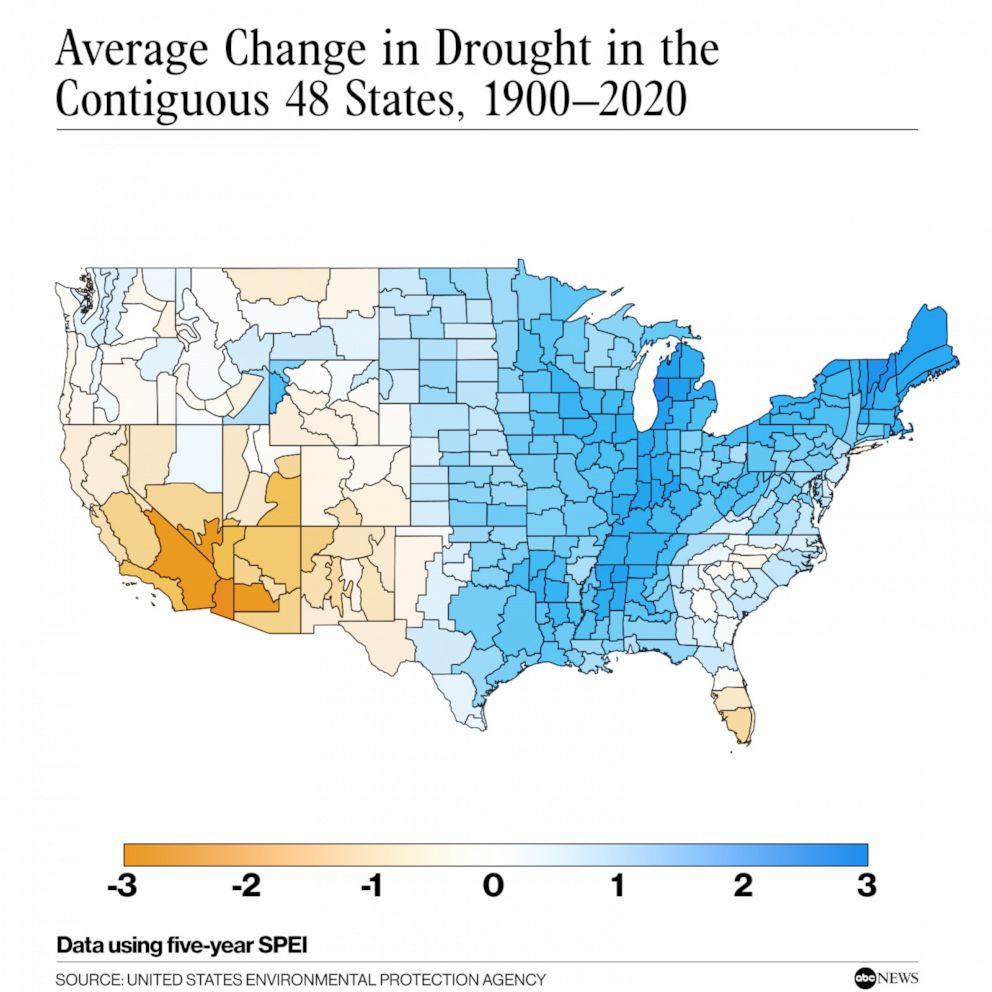
Average Change in Drought in the Contiguous 48 States, 1900–2020
ABC News, United States environmental protection agency
“We’re not going to engineer our way out of this problem,” Maxwell said. “It has to be engineering and conservation combined.”
The U.S. Department of Interior announced new options in April to preserve the critical Colorado River Basin that could significantly reduce water allocated for agriculture in states like Arizona, California, and Nevada.
How much does human-induced climate change play a role?
“We wouldn’t be here without climate change,” Udall said regarding the perilously low reservoirs of Lake Mead and Lake Powell. These reservoirs supply much of the water for the Southwest and are fed by the Colorado River.
“So, the reservoirs have lost about 60% of their contents since the year 2000 and now they’re at about 25% full,” said Udall.
While droughts are a normal part of Earth’s cycle, scientists have proven the current aridification or decadal drought in the West, often referred to as a “megadrought” is amplified by our rapidly warming world due to human activity.
For example, Udall said if we replicated the worst drought from the 20th century and made that the worst drought so far in the beginning of the 21st century we wouldn’t be in a crisis. “If that were the case, the reservoirs would be over 50% full and we wouldn’t be having a discussion at all about any kind of cuts.”
Warmer air is holding more drinking water captive
While parts of the West have seen record snowfall this winter season, all of that moisture won’t go directly to rivers and lakes. Evaporation will often take much of that newly fallen water away, back into the atmosphere, experts said.
In the Upper Colorado River Basin, Maxwell said evaporation is playing a key role in the West’s water crisis.
“The temperatures have increased consistently over the last 100 years and precipitation is variable, but hasn’t actually changed much. But with the increase in temperature there has been more evaporation and transpiration and that takes water directly out of the system,” Maxwell said.
“In this country, there is more water being transported between the land surface and the lower atmosphere than in all the rivers and streams combined,” said Maxwell. “As the atmosphere warms, its capacity for water only grows.”
A study from 2019 found that, in the United States, expected improvements in water use efficiency will be insufficient to avoid impending water shortages. Further, reductions in agricultural irrigation will be essential to contain shortages.
Flooding rainfall is making drinking water less safe
The largest source of surface freshwater in North America is the Great Lakes, totaling 84% of the continent’s surface freshwater and 10% of Americans’ drinking water.
But the Great Lakes are experiencing consequences from human activities.
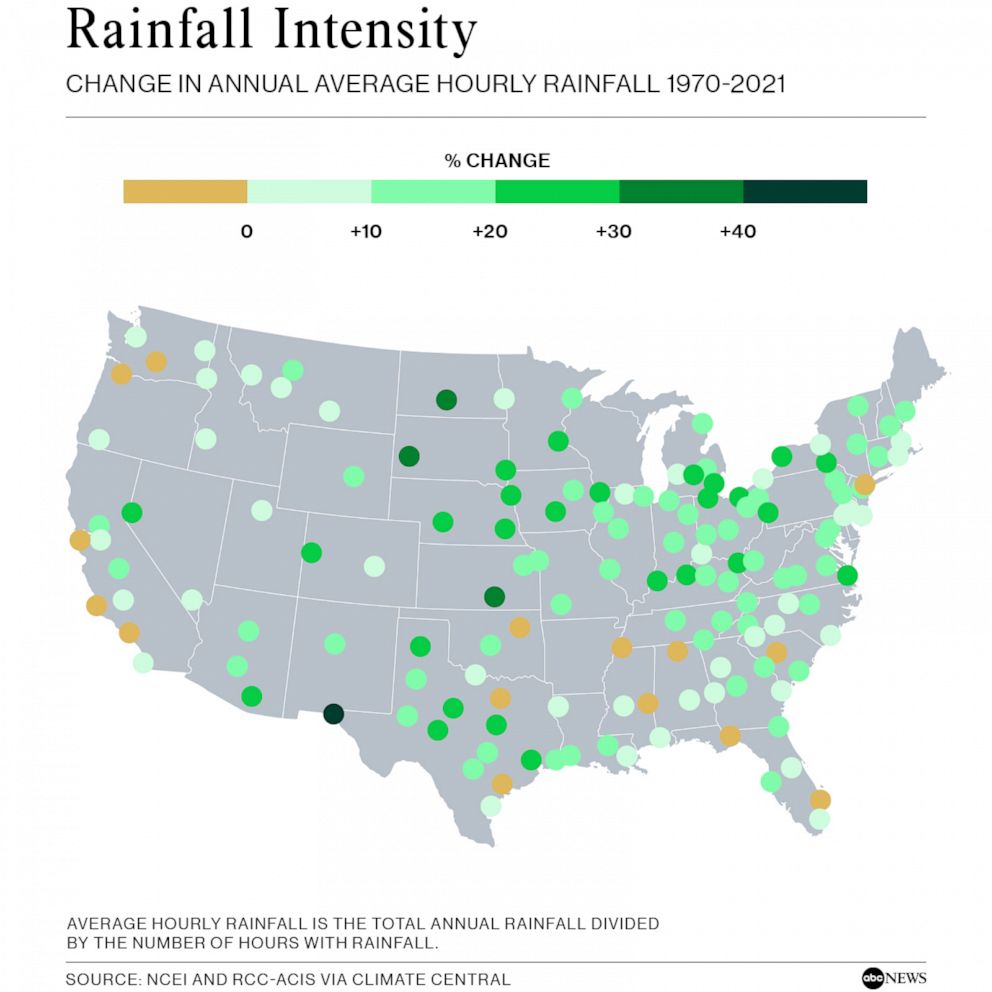
Rainfall Intensity 1970-2021
ABC News Photo Illustration, NCEI and RCC-ACIS via Climate Central
Fertilizer, human waste, animal waste, and even exhaust from vehicles create excess amounts of nitrogen and phosphorus and when flooding rains come it is washed into freshwater sources, such as the Great Lakes, rivers and reservoirs. In large flood events, which are and will be amplified by human-induced climate change, this nutrient dumping is expected to get worse.
According to the Environmental Protection Agency, “While nutrients are important, too much of a good thing can become a bad thing. In the U.S., 58% of rivers and streams, 40% of lakes and 21% of coastal waters have high levels of nutrients.”
By excess nutrients, they are talking about nitrogen and phosphorus, usually from fertilizer, human waste, animal waste, and exhaust from vehicles. In large flood events, which are and will be amplified by human-induced climate change, this nutrient dumping is expected to get worse. All those nutrients can fuel giant outbreaks of algal blooms.
All those excess nutrients can fuel giant outbreaks of algal blooms.
Harmful algal blooms (HABs) love warm, calm water; especially when it is also high in those excess, polluting nutrients, experts said. As we keep seeing longer and more intense warm seasons due to human-induced climate change, these bacteria are thriving, turning surface water toxic and undrinkable.
Toxic waters from algae have also been killing freshwater fish in lakes across the southern United States since 2000.
Water treatment plants cannot treat water with HABs, and can lead to the tap being shut off.
The water crisis is heading underground, too
The pollution from humans at the surface is also polluting groundwater, which makes up a third of American’ drinking water.
There is a decadal increase in groundwater nutrients, including some at levels considered toxic, in wells and aquifers in various parts of America. Some of the highest increases were found to be from chloride, lithium, nitrate, strontium, sulfate and uranium, according to data from the United States Geological Survey (USGS).
Not only do some of the nutrients reach the groundwater through seepage, but high-volume irrigation pumping also causes a mix of nutrients from both the surface and other rock along the way.
In sampling completed in 2015, the USGS found that 1 of every 5 groundwater samples from parts of aquifers used for drinking water contained a contaminant harmful to human health.
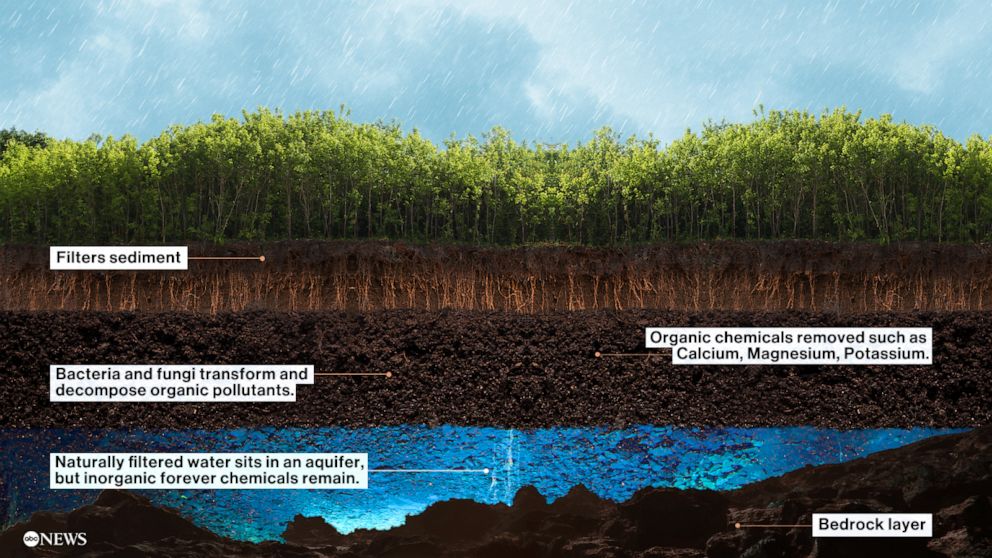
Water is naturally cleaned by the makeup of soil as it moves below the Earth’s surface. Often, manmade chemicals are not filtered in this process.
ABC News Photo Illustration
While some of these nutrients can be removed from groundwater in engineered treatment processes, 43 million Americans pull directly from private wells that usually don’t receive extensive treatment.
Forever chemicals, or PFAS, such as flame retardant, are not naturally removed from water moving through soil, our planet’s biggest water filter, as it travels to the wells and aquifers.
“Groundwater pollution can be cleaned up, but it is time consuming and very expensive,” said Maxwell.
In a recent first-of-its-kind announcement, the Environmental Protection Agency may regulate six types of PFAS in drinking water to ensure levels are low enough to be considered safe. The proposal may be approved by the end of the year. There are 12,000 chemicals in the PFAS category.
What can be done now
Conservation is key when it comes to water. For big problems, like what’s happening in the American West, Maxwell said states need to come together and figure out a fair compromise, “one that doesn’t shut off any one party completely. A real solution has to also accompany reductions in water use.”
As for what can be done at home, there are a few things people can do to help preserve water quality and quantity. To start, homeowners can consider a new grass-free lawn and double check pipes are sealed correctly. Experts said thousands of gallons are lost daily in homes around America due to leaks.
Communities can begin using graywater, or recycled non-wastewater, for toilet flushing. As for groundwater, replenishing dwindling aquifers may mean diverting snowmelt or rainwater to porous soil to make it easier for water to sink below the surface, like in California.
Maxwell said there is one piece of homework all of us can do to help. “The most important thing any one of us can do is to know where your water comes from. We’re all more likely to protect our drinking water when we know its source.”